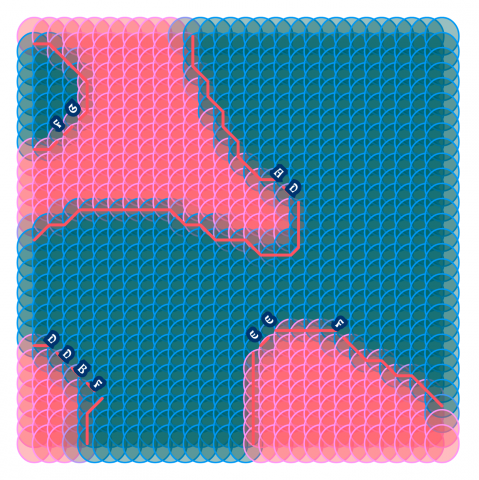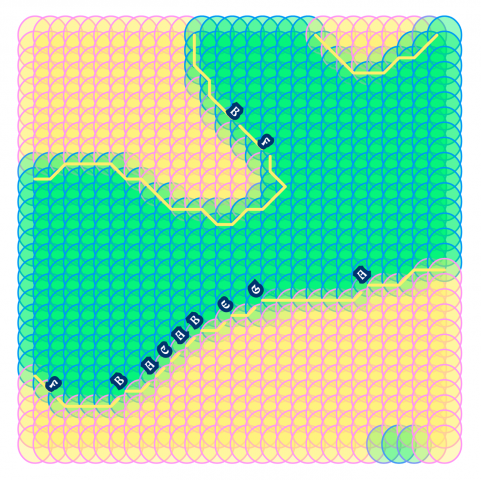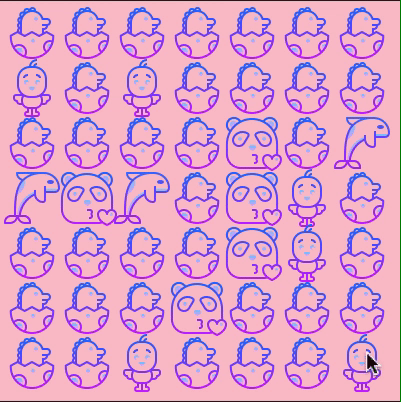A repeating theme from the sources is that time is dependent on experience, and the division of time shapes the world by structuring our experience of it. I never thought deep about time and its relation with experience, which is a highly subjective, intangible concept. This is super intriguing.
Author: pinkkk
pinkkk-meander
I. LOVE. THIS. WORK.
It’s so beautiful and elegant. Something I learned from it other than I wanna become someone like this is that math is so important. I am really contemplating taking more calculation-based math classes. Another key take way is his level of attentiveness to detail. Everything put on there has been thought out completely and he is still in the process of changing its logic to make it better.
pinkkk-02-LivingWallpaper

Computationally exported gif. Super pixelated 🙁 Loses all the details and subtleties

Screen Capture (Better quality)

Sketch
I am not satisfied with what I have, but it is due to my inefficient time management skills this week .. :/ I couldn’t get my smoke to look nicely with the fire. Also, I really felt my lack of basic skills in constructing very foundational shapes. It takes me forever to create a really simple shape.
I used the exponentialInOut, sineIn and sineOut from p5.func to animate the movement of the fire.
pinkkk-reading02
-
Where do you locate your interests along this spectrum?
I am more comfortable with creating last-word art, but I've always been trying to become someone that is brave enough to create first-word art. So I'd say that my current interest resides in first-word art because I want to be able to step out of my comfort zone more as an individual. I find myself trying to search for the correct answer with everything I do, and with that mindset, I will not be able to create first-word art. It's something I've always wanted to change about myself.
-
We might aspire to make stuff of lasting importance, but when our work is technologically novel, it doesn’t always age well. Discuss.
When a work is technologically novel, it's naturally the first of many in the innovative field, thus it is ground-breaking since it essentially is the new ground level. Therefore, it will be the ground of future work in this field, thus years later, people may find it to be less interesting or beautiful as the later last-word art.
pinkkk-LookingOutwards02

I chose Zackery Lieberman’s artwork, which he used OpenFrameworks to create. I find this piece to be extremely intriguing and beautiful. The way how the moving body interacts with computationally designed graphics is truly fascinating.
Pinkkk-Map
Generating in Action

Selected ScreenShots




Brief Paragraph About the Territory
My imaginary place is how I currently perceive myself. It is dominated by contrasting colors, ambiguous shapes, and undefined labels. Around the blended vibrant colors, there exist rigid lines holding back the circles that are on the edge of merging with the unknown.
Technical Process
From the beginning, I wanted to experiment with cartography, especially with the placement of labels. Therefore I focused the majority of my time on generating arbitrary terrains and orienting letters around it.
For my terrain generation, I utilized the Marching Squares algorithm to generate arbitrary sections with weighted vectors.

Problem 1: Orienting Text on a line
To orient the text, I took the dot product of the vectors and centered the text on the first vertex.

Problem 2: Collisions
The labels like the collide, and even when they are single-letters (used longer letters to demonstrate the problem). I approached the problem from two perspectives: controlling the number of labels on the map and detecting dark pixels on the screen. Both of the methods have their challenges such as hardcoding values and layering of visual elements. To be fair, I am not confident that they completely do not collide at all, and it would be an interesting problem to solve if I continue the project in the future.

pinkkk-IterationExercise01
pinkkk-reading01
The 10,000 Bowls of Oatmeal problem talks about when generated objects are mathematically unique versus perceptually unique. One idea that is closely related to perceptual uniqueness is perceptual differentiation.
Perceptual differentiation is when users identify the 2 object, the current and the last object as different objects at a glance. They just have to be visually different, but users may not remember them. On the other hand, perceptual uniqueness is when each artifact has their own personality which the viewers can recognize and remember.
In cases where the artists is building a dynamic background, perceptual differentiation of the background objects might be sufficient. For generative artifacts that are the center of a piece, perpetuation uniqueness shall be explored extensively.
This relates to building artifacts with readable traits that humans can relate to and identify with. This reminds me of a book I read on architecture, and it showcases how a slightly bent curve and convey a completely different feeling, and sometimes may constitute parts of a human representation, giving furnitures and architecture humanness. This applies to the plant project the author talks about, or essentially any artifact we generate. The closer it looks like human related objects, the more likely we are to identify and remember it.
pinkkk-lookingoutwards01


These are visualizations of eight different ways of shuffling 64 cards created by Roger Antonsen. I find concrete visualizations of rather complex mathematical concepts to be intriguing, and the output is splendid. The author created the project alone, and I wasn’t able to find a reliable source about his work process. Antonsen was inspired by Perci Diaconis, and wanted to experiment with exploring the various permutations underlying the shuffling methods. This art is also a complement to an academic paper he wrote Card Shuffling Visualization
This work resonates with me in particular because of my own interest in mathematics and pattern-finding. Visualizing abstract ideas to give tangibility and accessibility to daunting concepts intrigues me.
I found him through his compelling TedTalk: Math is the hidden secret to understanding the world | Roger Antonsen
Link to work: https://rantonse.no/en/art/2018-07-25
Some of his other beautiful generative art:

